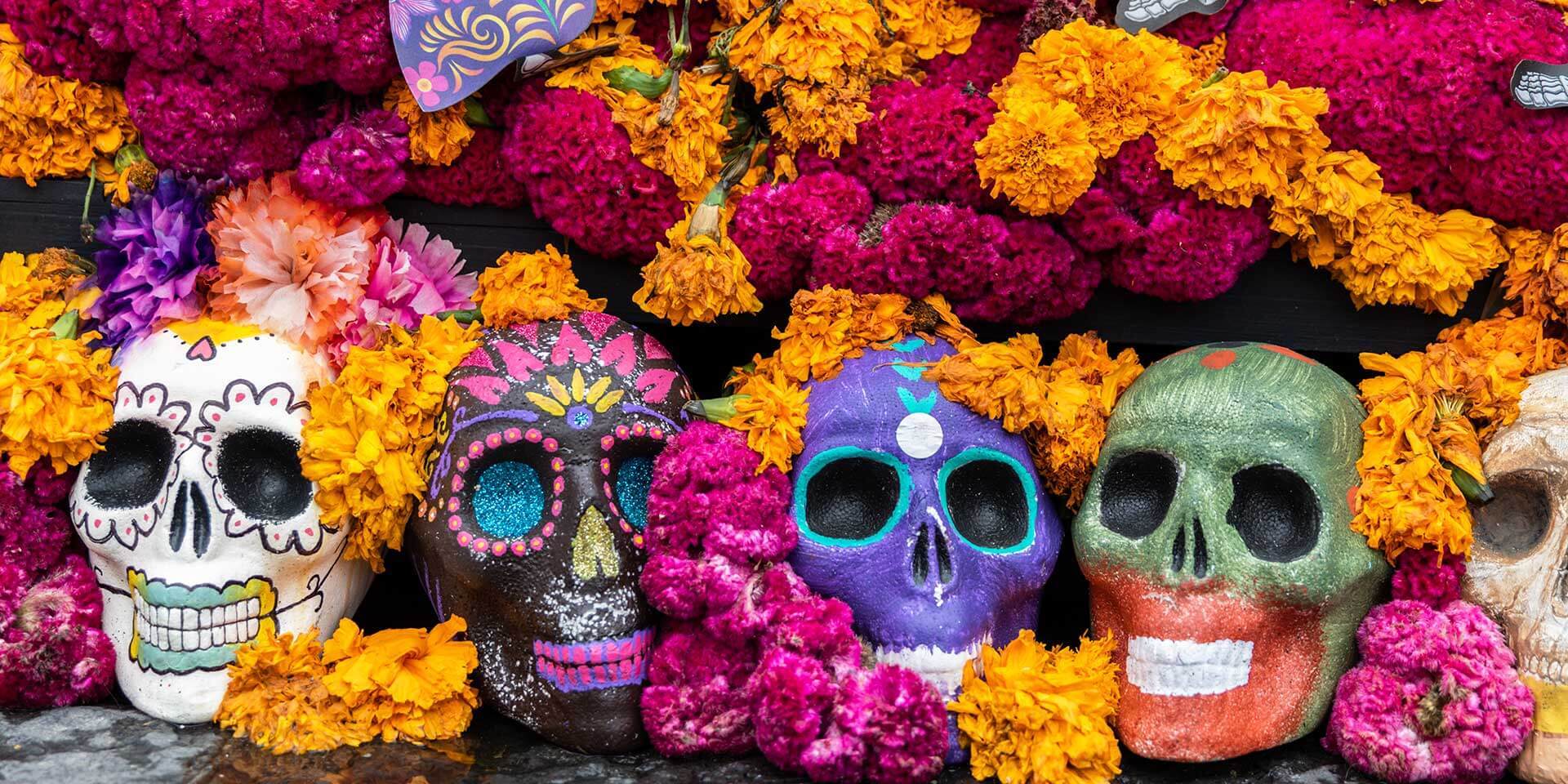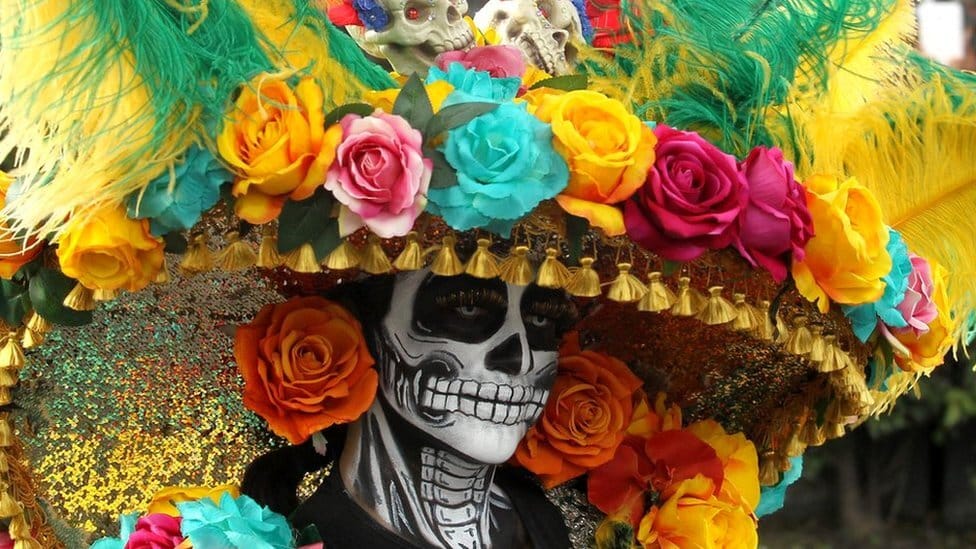- CDMX IYKYK
- Posts
- As long as we remember them, they are with us
As long as we remember them, they are with us
Día de Muertos, La Catrina & Juan Gabriel

!Feliz Viernes! 🎃
Mexico’s most colorful holiday is upon us: Día de Muertos! But first, Halloween, because apparently we need a few back-to-back days dedicated to costumes and sugar. The city is overflowing with parades, parties, and ofrendas, and I may or may not have fallen into a cempasúchil-induced haze while curating the events section.
In today’s issue, we dig into the origins of the ever-dramatic La Catrina, revel in Netflix’s new Juan Gabriel docuseries (because of course El Divo de Juárez deserves his own stage again), and unpack the latest from Mexico’s economic ups and downs — plus the usual U.S.–Mexico trade telenovela. Whether you’re honoring ancestors, dodging fog at the airport, or just in it for the pan de muerto, there’s something here for you.
– Rocio
Founder, Life of Leisure
Writer, Mexico News Daily
TODAY’S STORY

La Catrina: Death with Style
She’s everywhere this time of year — tall, elegant, draped in flowers and feathers, smiling her skeletal grin from parades, store windows, and ofrendas. La Catrina has become the unofficial face of Día de Muertos, but her story began long before she became Mexico’s most glamorous symbol of death.
Originally called La Calavera Garbancera, she was created in the early 1900s by printmaker José Guadalupe Posada, who used her to satirize Mexico’s upper class, people who rejected their Indigenous roots in favor of European airs. “Todos somos calaveras,” Posada famously said: we are all skeletons. His message was clear: no matter your wealth, class, or power, death spares no one.
A few decades later, Diego Rivera resurrected her in his 1947 mural Dream of a Sunday Afternoon in Alameda Central, giving her the elegant hat, long dress, and name she’s known by today, “La Catrina” which is synonymous with the rich and pompous. Standing beside Rivera and Frida Kahlo, La Catrina became more than a political cartoon; she became a cultural icon. A reminder that death isn’t something to fear or hide from, but to face with grace, humor, and even a little vanity.
Today, La Catrina is celebrated as both memento mori and muse. She embodies the Mexican view of death not as an ending but as a continuation, a reason to dress up, laugh, and toast to the lives that came before us. Behind her grin is a quiet truth: death, like life, deserves to be met beautifully.
TOP NEWS
🎤 Netflix’s Juan Gabriel: I Must, I Can, I Will opens the vault on the Mexican singer’s extraordinary life, drawing from videos, audio recordings, and photos he captured himself over more than four decades. Released on October 30, the docuseries lands just in time for Día de Muertos — the perfect weekend to remember El Divo de Juárez in all his brilliance.
✈️ President Sheinbaum pushes back after the U.S. revokes 13 Mexican airline routes. The decision by U.S. authorities to cancel multiple routes operated by Mexican carriers has sparked criticism from Sheinbaum, who called the move “unjustified” and said her administration will seek to resolve the issue through diplomatic channels.
👻 The creepiest spots to visit in CDMX this spooky season. From haunted hospitals and shadowy alleyways in the Centro Histórico to the eerie canals of Xochimilco, Mexico City has no shortage of ghost stories. Mexico News Daily rounds up the capital’s most chilling legends and paranormal hot spots — if you dare.
🗑️ CDMX to roll out new three-bin garbage system in 2026. Starting January 2026, the city will launch Transforma tu Ciudad, Cada Basura en su Lugar (“Transform your City, Each Garbage in its Place”), a new waste separation and collection program that will require residents to sort trash into three categories to improve recycling and reduce landfill waste.
🎬 Guillermo del Toro’s Frankenstein already hailed as a modern classic. The Mexican filmmaker’s long-awaited adaptation is earning early acclaim for its haunting beauty and emotional depth. Now showing in select cinemas, the film will be released on Netflix November 7.
💊 Mexico extradites suspected Chinese fentanyl kingpin to the U.S. Authorities confirmed the handover of a man accused of trafficking precursor chemicals used to produce fentanyl, marking a rare cross-border move amid growing U.S. pressure on Mexico and China to curb the flow of the deadly drug.
🚴🏽♀️ CDMX’s Yareli Acevedo makes cycling history. The Mexico City native won gold in the women’s points race at the 2025 UCI Track Cycling World Championships in Santiago, becoming the first Latin American athlete ever to claim the title.
🤝 Sheinbaum and Trump agree to extend USMCA trade talks. President Sheinbaum said she and President Trump agreed to prolong negotiations for a few more weeks, delaying new U.S. tariffs on Mexican goods that were set to take effect November 1 — a move aimed at maintaining trade stability under the current agreement.
🕒 Mexico to present 40-hour workweek reform in November. Lawmakers are expected to debate a proposal that would reduce the standard workweek from 48 to 40 hours, a long-awaited labor reform aimed at improving work-life balance for millions of Mexican workers.
FEATURED EVENT
Rooted: Full Moon Circle 🌕
Nov 5 | 7:30–8:30PM (Online)
Feeling a little untethered lately? This Taurus Full Moon is your reminder to slow down and reconnect. We’ll journal, breathe, and share under the moonlight — from wherever you are.
✨ Donation-based
💻 Replay included
CULTURE & HAPPENINGS
Fri, Oct 31: Day of the Dead Mega Ofrenda & Opera (Centro) 🎭
Fri, Oct 31: México de mis Sabores (Santa Maria Ribera) 🌶️
Sat, Nov 1:CDMX Day of the Dead Parade (Reforma) 🖤
Sat, Nov 1: Day of the Dead Experience + Walking Tour (Centro) 🏵️
Sun, Nov 2: Feria de Día de Muertos (Coyoacán) 🥀
Sun, Nov 2: Festival de Calaveras y Catrinas (San Angel) 💀
Mon, Nov 3: Talk Trivia To Me (Condesa) 🤯
Tues, Nov 4: Advertising Week LATAM 📢
Wed, Nov 5: Rooted: A Full Moon Women's Circle (Online) 🌕
Thur, Nov 6: Galería Alentar Exhibit ‘Tiene Sentido’ (Roma N) 💡
Fri, Nov 7: Danza de la Llorona (UNAM) 😭
Sat, Nov 8: Comuna: Mujeres Group Walk (Chapultepec) 👟
Sat, Nov 8: Juan Gabriel’s Concert Projection (Zócalo) 🎤
Sun, Nov 9: Lagunilla Antique Market & Bazaar 🛍️
Mon, Nov 10: Art Club Mondays (Condesa) 🖌️
Wed, Nov 12: Trendy Dinners w/ Like-Minded Strangers (Centro) 🍝
Wed, Nov 12: Homenaje Sinfónico a Juan Gabriel (Auditorio Nacional) 🎵
Thur, Nov 13: A Journey to Mictlán (Escandon) 🕯️
Fri, Nov 14: Chicas, Coffee & Connections (Roma N) ☕
Sat, Nov 15: Mezcal Tasting at Hotel Parian (Roma N) 🍋🟩
Want your event featured? IYKYK is published around the 15th and 30th of each month. Please send the internet link to the specific event you would like to include 3 days prior to these dates.
DID YOU KNOW?
That Xoloitzcuintli — Mexico’s ancient hairless dog — has been around for more than 3,000 years? Named after the Aztec god Xólotl, these dogs were believed to protect their owners in life and guide their souls safely to the underworld after death (but only if they’d been kind to dogs!). Once nearly wiped out during Spanish colonization, Xolos made a comeback thanks to Frida Kahlo and Diego Rivera, who kept them as pets and immortalized them in art. Today, the Xolo stands as a symbol of Mexican identity — a living link between the spiritual and the earthly, still seen on ofrendas during Día de Muertos and in homes across the country.
ROCIO RECOMMENDS
With Día de Muertos just around the corner, it’s the perfect time to lean into a perfectly bizarre & surreal show — Los Espookys on HBO Max. This brilliantly weird bilingual comedy celebrates Latin America’s love of the spooky and surreal. Set in an unnamed country that feels part Mexico, part Chile, it follows a group of friends who turn their obsession with horror into a business staging supernatural events. Equal parts camp and clever, it’s a reminder that in our culture, we don’t fear the dark — we have fun with it.
VIRAL VAULT
Witchy vibes forever
Single lifestyle, upgraded
Men full of green flags
Thanks for being a reader of CDMX IYKYK! If you'd like to support this passion project, feel free to treat me to a ☕️
Why CDMX IYKYK?
Because staying in the know shouldn’t require 12 tabs, 5 group chats, and a rabbit hole of IG accounts. I created this newsletter to help fellow expats, digital nomads, and the Mexican diaspora feel more connected to life in Mexico — not just the highlights, but the context behind them too.
As someone who spent her childhood in Mexico and came of age across borders, I bring cultural insight that goes beyond translation. This isn’t just curated info; it’s grounded in lived experience, curiosity, and cariño for the motherland.
Whether you’re in Mexico City for a few months or forever, I hope this space helps you navigate, appreciate, and engage more deeply with the city we’re lucky to call home.
🧠 Got an event, tip, or cultural gem to share? Just hit reply to this.
Not subscribed yet? Join the community — it’s free, fun, and muy informed.
See you in two weeks!


